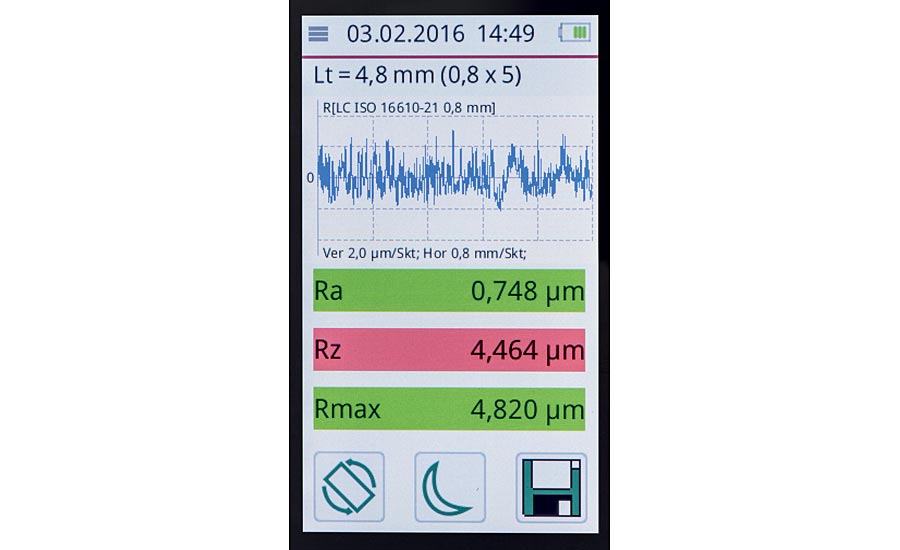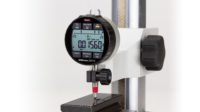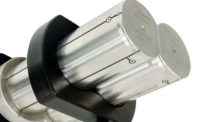All types of gaging, whether it be hand tools, comparative gages, complex measuring stations or portable surface finish gages, have long gone digital. Many of today’s digital gages can perform complex measuring tasks and share information faster and easier than systems produced 10 years ago.
In many facilities, the quality control technician monitoring part quality in an inspection room, in a far corner of the plant, long after the product was produced is so 20th century. The norm today is monitoring part quality at the point of manufacture. This allows operators to inspect the part for quality and, using process control techniques, prevent bad parts from being produced. However, production operators have been trained to run fast, powerful and complex machine centers; they are not necessarily trained as quality control technicians. Thus, the gaging that is placed into the machinist’s hands must produce accurate and reliable measurements and also be easy to use without additional training.
This has created an underlying trend to make all gaging easier to use with more powerful capabilities – along with the ability to survive the tough working environment in which they will be used. Where is the inspiration for ease-of-use coming from? Many innovative gaging features are inspired by the smart phones and tablets that today’s machinists have grown up using. They are experienced with digital technology and can quickly go from one device to the next without skipping a beat. It is only logical to build on this familiarity and incorporate similar interfaces into today’s gaging at the point of manufacture.

But it’s not only the user interface that inspires trends in new gaging products. Smartphone displays offer HD quality clarity and speed of response; the materials being used are futuristic, and even battery technology can extend the use of mobile products. Bringing these advances in operation, materials and displays to gages provides users with gaging capabilities never seen before, and offers more value.
Make It Look And Act Like A Smart Phone
The latest portable surface gages interface with the user just like a smart phone. Today, swiping, tapping and expanding are second nature to many people. In fact, because of this, most are confident handling a device that looks like a smart phone and, with the right user interface, they can become instantly familiar with it. Thus, the trend is to build on users’ familiarity with digital technology from using other products so that new users, even those not familiar with a particular field, will require very little training and can operate new gages within minutes.
Still, machinists are under a lot of production pressure and are not experts in surface finish. To the machinist and user of the surface finish systems, this most likely means new parameters, tolerances and set-up information are specified for each new part manufactured. Even with the simplest surface finish system, there are literally hundreds of possibilities in set-up parameters.
Just like a camera in a smart phone will often be set to an auto mode on a phone, a mobile surface gage can be set up similarly. There are modes in many tools today for error-free operation through international standard-compliant settings and automatic cutoff selection which ensures even non-measurement technicians can obtain the correct measurement results. Making good measurements is really as easy as pressing the start button to begin the measuring trace.

Gaging In HD
In spite of the digital revolution, there are some functions where an analog readout may be more practical. A simple example comes to mind when trying to read and make a decision on a digital display where the reading may be changing due to a dynamic situation—for example, rotating a part for diameter change or searching for a high spot while sweeping through a bore. A brief glance by a trained operator may be all that is needed to detect presence, distance, direction and even size on an analog dial. Just watching the sweep of the needle across the dial of an analog amplifier may provide all the information a machinist needs to make the right decision to maintain control over his process—even without actually reading any numbers from the dial.

There have been many digital bench amplifiers in the past that tried to simulate the motion of a digital display, but the results were often unimpressive. The analog simulator would be slow to react or skip segments as the display tried to keep up with the transducer signal. It was not sufficient for an experienced operator to get those direction and distance signals needed for the measurement.
PC gaging systems with newer monitors began to provide a means of simulating good analog display. But only recently has HD display been added to bench amplifiers. Today the same types of LED displays found in smart phones are making their way into bench amplifiers and virtually simulating the screen resolution and performance of a high-quality monitor. Not only are color and high resolution possible, but speed of response is the key to simulating an analog meter. Now that analog bar graph on a bench amplifier can respond even faster than an analog meter and look just as “smooth” – no jumping or skipping segments.
Also, since the display is basically a smart phone screen it can be changed per the measuring applications from a single digital display or combination analog/digital readout. Or for a more complex gaging display, one, two or more results with different configurations on the same screen can be generated, all in color for part classification and easy decision making for the users.

New Materials For Tough Shop Environments
The materials and coating used on the volumes of electronics on the market today has become important because of the look, manufacturability and environmental concerns involved in creating the appearance of some pf these products. Take the chroming processes for example. Many users like the clean shine of a chromed product. Manufacturers have also relied on chrome to provide long wear life and prevention of rust. However, environmentally, chrome has become a very large problem and a major source of pollution. It is only a matter of time before many forms of chroming become so regulated that it will become cost prohibitive.
Therefore, the industry has increasingly turned to Physical Vapor Deposition (PVD) as a way of creating good looking and functional appearances on parts that satisfy their purpose without the environmental concerns. Various PVD processes have been developed and adapted; some purely for looks, others made specifically for a particular function. Take cutting tool bits for example. Extremely hard materials were often used for cutting tools, but the development of coating has transformed the industry to where specific types of coating are applied to a base material, producing products with extreme wear characteristics.
Once again, gaging manufacturers are taking advantage of these industry-specific developments and using them to their own benefit. Chroming was often either a standard feature or a custom option for various gages or contacts on gages to increase wear. Additionally, chroming may have been an option that was selected when the gaging was going to be used in a harsh, humid environment where rust was a serious concern. Gages are also now utilizing some of the PVD processes used in the cutting tool industry to help them last longer and prevent rust, and help the environment by reducing the need for chroming operations.
Case in point is mechanical plug gages and air tooling. Both can be subjected to high wear applications and used in wet/humid environments. Normally, chrome would have been specified as a means to handle increased wear. A special coating, such as AlCrNi (Aluminum Chromium Nitride composition), can be applied to gages that adds very minimal size change while offering extreme hardness for long life in some of the most demanding manual and automated processes.
One of the benefits of this coating is its color, which tends to be darker than the base material it is applied to. Therefore, should the tool at some point wear through the diamond-like coating of the material, one would be able to see the marks, providing an inspection process for worn tooling. For automated measuring systems, this is an important feature since it can be visible in process and would not require dimensional checking of the tool outside the process.
Most mechanical and air plug tooling can be high volume and not necessarily part of an automation process. The tools with this new coating will most likely outlast the production runs they were designed for.
Thus, there are many benefits: an environmentally friendly manufacturing process, harder surfaces, no chipping or rusting and a look that can help identify wear should it ever happen. Again, another example of new technologies being brought into the gaging world.
Technology Moving The Industry
Basically, proper dimensional measurement comes down to physics and metrology. There are basic rules, true today and always, that have to be followed to achieve good results. But technology developed for other products and industries can be adapted to today’s gages. Implementing these new technologies will make today’s gages easier to use, offer more capabilities in an easier-to-read fashion and survive point of manufacture gaging.



